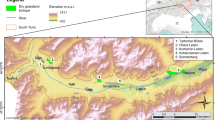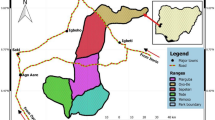Abstract
The paper introduces two types of models: the “memory of a landscape” and the “face of a landscape”. The memory of a landscape refers to the development of a landscape as a result of many small and some major events. It can be described by a multitude of features that are difficult to change by humans, such as the initial geological substrate and the availability of nutrients linked to it. The implementation of the “memory model” leads to a scientific modelling approach that models the influence of the basic factors on forest distribution. The face of a landscape on the other hand implements a Big Data approach. The face can be changed more easily, e.g. by clearing forest areas and converting them into arable land. Both types of models are used to conclude from today’s perspective on the development of historical forests around 1880. A machine learning algorithm is used to implement both model types and evaluate the importance of features. Both models show differences in accuracy and simulation, which are discussed in detail. The inherent evaluation of the importance of the model inputs can be used to critically review some doctrines. The combination of machine learning with the knowledge of experts who help to select and prepare the data can be used in the future to depict the memory of a landscape more comprehensively in a model than is possible with previous approaches.



Similar content being viewed by others
References
European Treaty Series No. 176, http://www.coe.int/en/web/conventions/ Accessed April 12, 2018.
Steinhardt, U., Blumenstein, O., & Brasch, H. (2012). Lehrbuch der Landschaftsökologie (Textbook of Landscape Ecology). Heidelberg. https://doi.org/10.1007/978-3-8274-2397-9.
Haase, G., Barsch, H., Hubrich, H., Mannsfeld, K., & Schmidt, R. (1991). Naturraumerkundung und Landnutzung, Geochorologische Verfahren zur Analyse, Kartierung und Bewertung von Naturräumen (Exploration of natural environment and land use, geochorological methods for the analysis, mapping and evaluation of natural environment). Beiträge zur Geographie 34. Akademie Verlag, Berlin.
Leonhardt, S., Scheinsohn, V., Rizzo, F., & Tchilinguirián, P. (2016). The memory of the landscape: Surface archaeological distributions in the Genoa Valley (Argentinean Patagonia). Quarternary International, 422, 5–16. https://doi.org/10.1016/j.quaint.2015.11.131.
Brierley, G. J. (2010). Landscape memory: The imprint of the past on the contemporary landscape forms and processes. Area, 42, 76–85. https://doi.org/10.1111/j.1475-4762.2009.00900.x.
Ogle, K., Barber, J. J., Barron-Gafford, G. A., Bentley, L. P., Young, J. M., Huxman, T. E., et al. (2015). Quantifying ecological memory in plant and ecosystem processes. Ecology Letters, 18, 221–235. https://doi.org/10.1111/ele.12399.
Padisak, J. (1992). Seasonal succession of phytoplankton in a large shallow lake (Balaton, Hungary): A dynamic approach to ecological memory, its possible role and mechanisms. Journal of Ecology, 80, 217–230. https://doi.org/10.2307/2261008.
Peterson, G. D. (2002). Contagious disturbance, ecological memory, and the emergence of landscape pattern. Ecosystems, 5, 329–338. https://doi.org/10.1007/s10021-001-0077-1.
Jenkins, D. J. (Ed.). (2002). Remaking the landscape. The changing face of Britain. Suffolk: Profile Books.
Lipsky, Z. (1995). The changing face of the Czech rural landscape. Landscape and Urban Planning, 31, 39–45. https://doi.org/10.1016/0169-2046(94)01034-6.
Pfeiffer, E. (2013). The earth’s face- landscape and its relation to the health of the soil. North Carolina: Sanford Press.
Foster, D. R., Swanson, F. J., Aber, J., Burke, I., Brokaw, N., Tilman, D., et al. (2003). The importance of land-use legacies to ecology and conservation. BioScience, 53, 77–88. https://doi.org/10.1641/0006-3568(2003)053%5b0077:TIOLUL%5d2.0.CO;2.
Hermy, M., & Verheyen, K. (2007). Legacies of the past in the present-day forest biodiversity: A review of past land-use effects on forest plant species composition and diversity. Ecological Research, 22, 361–371. https://doi.org/10.1007/s11284-007-0354-3.
Leuschner, C., & Ellenberg, H. (2017). Vegetation ecology of central Europe, Vol. 1. Ecology of Central European Forests.. Cham: Springer International Publishing Switzerland. https://doi.org/10.1007/978-3-319-43042-3.
Foley, J. A., DeFries, R., Asner, G. P., Barford, C., Bonan, G., Carpenter, S. R., et al. (2005). Global Consequences of Land Use. Science, 309, 570–574. https://doi.org/10.1126/science.1111772.
Zimmermann, F. (2003). Biotopkartierung Brandenburg, Band 1: Kartierungsanleitung und Anlagen (Biotope Mapping Brandenburg, Volume 1: Mapping Instructions and Annexes). Verlag des Landesumweltamtes Brandenburg, Potsdam.
Zimmermann, F. (2007). Biotopkartierung Brandenburg, Band 2—Beschreibung der Biotoptypen (Biotope Mapping Brandenburg, Volume 2—description of the biotope types). 3. Auflage. Verlag des Landesumweltamtes Brandenburg, Potsdam.
Wieland, R., Dalchow, C., Sommer, M., & Fukuda, K. (2011). Multi-scale landscape analysis (MSLA): A method to identify correlation of relief with ecological point data. Ecological Informatics, 6, 164–169. https://doi.org/10.1016/j.ecoinf.2010.09.002.
Corominas, L. L., Garrido-Baserba, M., Villez, K., Olsson, G., Cortés, U., Poch, M. (2017). Transforming data into knowledge for improved wastewater treatment operation: A critical review of techniques. Environmental Modelling & Software https://doi.org/10.1016/j.envsoft.2017.11.023.
Amt für Statistik Berlin-Brandenburg (2016) Die kleine Brandenburg-Statistik (The small Brandenburg statistics). Potsdam.
Amt für Statistik Berlin-Brandenburg (2016) Statistischer Bericht (Statistical Report) A V 3-j/16. Potsdam.
Ministerium fuer Ländliche Entwicklung, Umwelt und Verbraucherschutz (MLUL, ed (2017)) Waldzustandsbericht 2017 des Landes Brandenburg (Forest Condition Report 2017 of the State of Brandenburg). Landesbetrieb Forst Brandenburg, Landeskompetenzzentrum Forst Eberswalde (LFE), Eberswalde.
Landesumweltamt (LUA, ed (2009)) Umweltdaten Brandenburg (Environmental Data of Brandenburg) 2008/2009. Potsdam.
Kühn, D., Bauriegel, A., Mueller, H., & Rosskopf, N. (2015). Charakterisierung der Böden Brandenburgs hinsichtlich ihrer Verbreitung, Eigenschaften und Potenziale mit einer Präsentation gemittelter analytischer Untersuchungsergebnisse einschließlich von Hintergrundwerten (Korngrößenzusammensetzung, Bodenphysik, Bodenchemie) (Characterisation of the soils of Brandenburg with regard to their distribution, properties and potentials with a presentation of averaged analytical results including background values (particle size composition, soil physics, soil chemistry)). Brandenburger Geowissenschaftliche Beiträge, 22, 5–135.
Umweltbundesamt. (2010). Die Böden Deutschlands. Sehen, Erkunden, Verstehen (The soils of Germany. Watching, exploring, understanding). KOMAG mbH, Berlin.
IUSS Working Group WRB. (2006). World reference base for soil resources 2006. World Soil Resources Reports 103. FAO, Rome.
http://inspire.ec.europa.eu Accessed April 9, 2018.
Silva, W. G., Metzger, J. P., Simões, S., & Simonetti, C. (2007). Relief influence on the spatial distribution of the Atlantic Forest cover on the Ibiúna Plateau. Brazilian Journal of Biology, 67, 403–411.
Ministerium fuer Ländliche Entwicklung, Umwelt und Verbraucherschutz (MLUL, ed (2006)) Strategische Umweltprüfung im Rahmen der Ex-ante Bewertung des Entwicklungsplans für den ländlichen Raum Brandenburgs und Berlins (Strategic environmental assessment as part of the ex-ante evaluation of the rural development plan for Brandenburg and Berlin) (EPLR) 2007–2013. Selbstverlag, Potsdam.
Foster, D. R. (1992). Land-use history (1730–1990) and vegetation dynamics in central New England, USA. Journal of Ecology, 80, 753–772. https://doi.org/10.2307/2260864.
Brownlee, J. (2017). Time Series Forecast Project. In J. Brownlee (Ed.), Introduction to time series forecasting with python (pp. 249–254). Vermont Victoria: Machine Learning Mastery.
Silipo, R., Adae, I., Hart, A., & Berhold, M. (2014). Seven Techniques for Dimensionality Reduction, KNIME. https://files.knime.com/sites/default/files/inline-images/knime_seventechniquesdatadimreduction.pdf Accessed April 9, 2018.
McKinney, W. (2012). Python for data analysis. Sebastopol: O’Reilly Media Inc.
Pedregosa, F., Varoquaux, G., Gramfort, A., Michel, V., Thirion, B., Grisel, O., et al. (2011). Scikit-learn: Machine learning in python. Journal of Machine Learning Research, 12, 2825–2830.
DeCoste, D. (2002). Training invariant support vector machines. Machine Learning, 46, 161–190. https://doi.org/10.1023/A:1012454411458.
Breiman, L. (1996). Bagging predictors. Machine Learning, 24, 123–140. https://doi.org/10.1023/A:1018054314350.
Breiman, L. (2001). Random forests. Machine Learning, 45, 5–32. https://doi.org/10.1023/A:1010933404324.
Gigerenzer, G., & Brighton, H. (2009). Homo heuristicus: Why biased minds make better inferences. Topics in Cognitive Science, 1, 107–143. https://doi.org/10.1111/j.1756-8765.2008.01006.x.
Bergstra, J., & Bengio, Y. (2012). Random search for hyper-parameter optimization. Journal of Machine Learning Research, 13, 281–305.
Wieland, R., Kerkow, A., Frueh, L., Kampen, H., & Walther, D. (2017). Automated feature selection for a machine learning approach toward modeling a mosquito distribution. Ecological Modelling, 352, 108–112. https://doi.org/10.1016/j.ecolmodel.2017.02.029.
Chen, T., & Guestrin, C. (2016). XGBoost: A scalable tree boosting system. In: Proceedings of the 22nd ACM SIGKDD international conference on knowledge discovery and data mining. San Francisco, California, USA.
Wulf, M., Jahn, U., & Meier, K. (2016). Land cover composition determinants in the Uckermark (NE Germany) over a 220-year period. Regional Environmental Change, 16, 1793–1805. https://doi.org/10.1007/s10113-016-0930-6.
Ministerium fuer Landwirtschaft, Umweltschutz und Raumordnung (MLUR, ed (2002)) Informationsheft zum landwirtschaftlichen Bodenschutz im Land Brandenburg, Teil Bodenerosion (Information booklet on agricultural soil protection in Brandenburg, part soil erosion). Verlag der Landesanstalt für Landwirtschaft des Landes Brandenburg, Potsdam.
Vasander, H., Tuittila, E. S., Lode, E., Lundin, L., Ilomets, M., Sallantaus, T., et al. (2003). Status and restoration of peatlands in northern Europe. Wetland Ecology and Management, 11, 51–63. https://doi.org/10.1023/A:1022061622602.
Mückenhausen, E., Scharpenseel, H. W., & Pietig, F. (1968). Zum Alter des Plaggeneschs (On the age of Plaggept). Eiszeitalter und Gegenwart, 19, 190–196. https://doi.org/10.3285/eg.19.1.13.
Glatzel, G. (1991). The impact of historic land use and modern forestry on nutrient relations of Central European forest ecosystems. Fertilizer Research, 27, 1–8. https://doi.org/10.1007/BF01048603.
Xu, Z., Guan, K., Casler, N., Peng, B., & Wang, S. (2018). A 3D convolutional neural network method for land cover classification using LiDAR and multi-temporal Landsat imagery. ISPRS Journal of Photogrammetry and Remote Sensing, 144, 423–434, ISSN 0924-2716.
Zhu, Z., & Evans, D. L. (1994). U.S. forest types and predicted percent forest cover from AVHRR data. Photogrammetric Engineering & Remote Sensing, 60, 525–531.
Author information
Authors and Affiliations
Corresponding author
Electronic supplementary material
Below is the link to the electronic supplementary material.
Rights and permissions
About this article
Cite this article
Wieland, R., Wulf, M. & Meier, K. What makes the difference between memory and face of a landscape? A machine learning approach applied to the federal state Brandenburg, Germany. Spat. Inf. Res. 27, 237–246 (2019). https://doi.org/10.1007/s41324-018-0228-5
Received:
Revised:
Accepted:
Published:
Issue Date:
DOI: https://doi.org/10.1007/s41324-018-0228-5




